Well, if we're going with local..
Leeds Girls High School is where my older sister went to school. It's original building is a 1900's brick and tile school in the leafy borough of Headingley, and the school consistently scored amongst the highest in the region academically. The school had several buildings, with the Senior School and Rose Court (the infant school) situated on Headingley Lane while the Junior School set up shop a mile down the road in a converted manor, Ford House.
In 2005 the LGHS administration formed a merger with the administration Leeds Grammar School (my school) and the student populations were physically merged in 2008, moving to the LGS's more modern campus to the north of the city in Alwoodley Gates. Together they are now The Grammar School At Leeds which, I agree, is a terrible name.
But this does mean there's a 1900's era former school sitting surrounded by grass and trees, going pretty much unused. A TV company did spruce a bit of it up in 2010 to use as a set for a medical drama, turning it into the fictional Saint Matthews Hospital. This means that, yes, it is both an abandoned school AND an abandoned hospital.

Gosh, that's not even slightly haunted.

Oh good.

Oh
good.


"Fire the missiles, children."

This is Rose Court, where the 3-7 year olds were en
tombedrolled.
 This is where we keep the little ones..
This is where we keep the little ones..

Remember how this used to be a location for a medical drama? Well, it also used to be a school that taught things like chemistry. So have fun figuring out what's real and what's a prop.